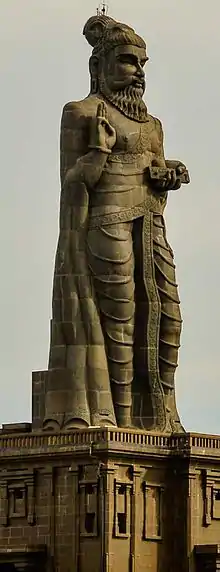Thiruvalluvar Temple, Mylapore
Thiruvalluvar Temple, also known as the Ekambareswarar–Kamakshi Temple, is a Hindu temple dedicated to the poet-saint Valluvar in the neighborhood of Mylapore in Chennai, India. The shrine is located within the Ekambareswarar temple complex. Believed to have been constructed in the early 16th century, the temple was extensively renovated in the 1970s.[2] Traditionally believed to be the birthplace of Saint Valluvar, the temple is the oldest ever built to Valluvar. The temple also serves as the venue for meetings of Tamil language enthusiasts. While many consider the temple as the birthplace of Valluvar, some consider it as his samadhi (place of cremation).
| Thiruvalluvar Temple | |
|---|---|
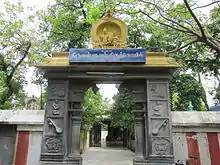 Thiruvalluvar Temple in Mylapore | |
| Religion | |
| Affiliation | Hinduism |
| Deity | Valluvar and Vasuki |
| Location | |
| Location | M. K. Amman Street, Mylapore, Chennai, India |
| Country | India |
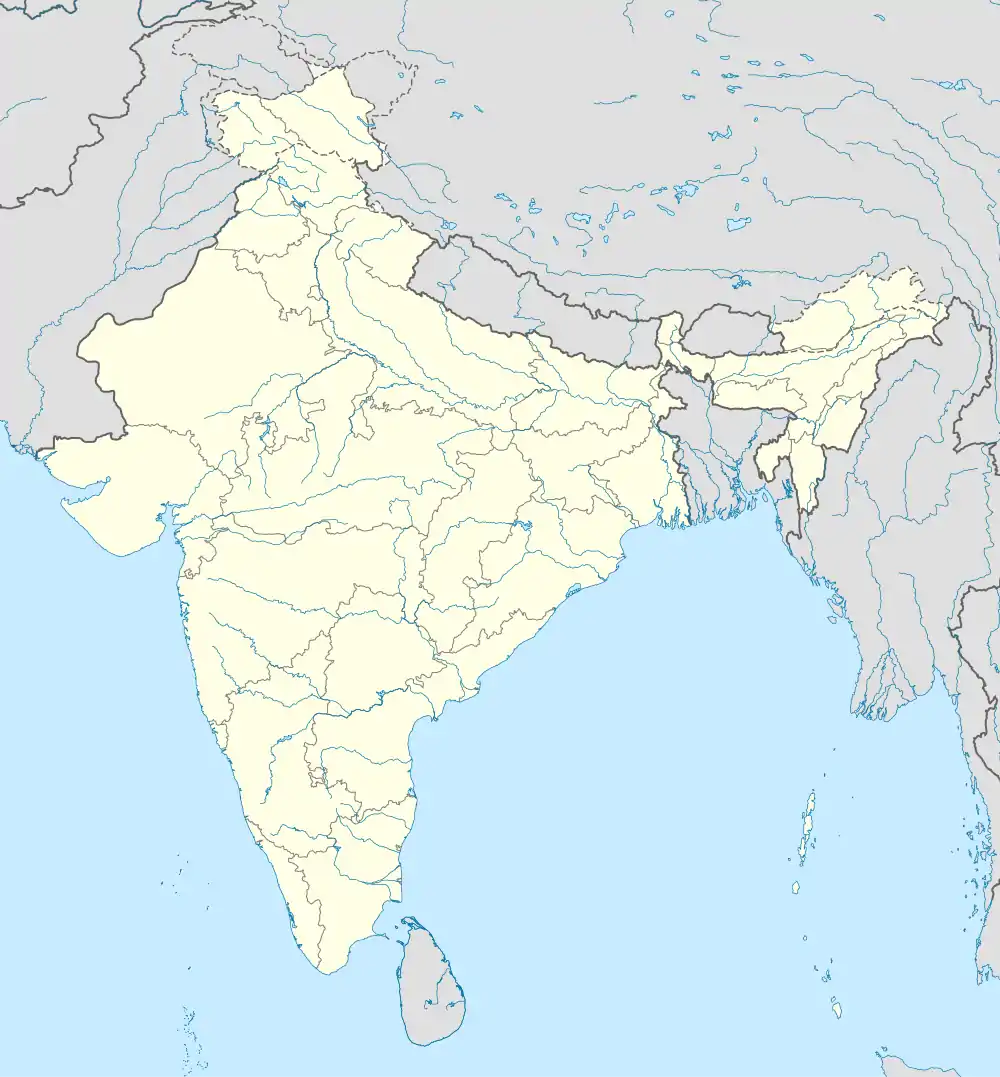 Shown within India | |
| Geographic coordinates | 13.0398073°N 80.2710717°E |
| Architecture | |
| Completed | Early 16th century (present structure)[1] |
Tradition and history
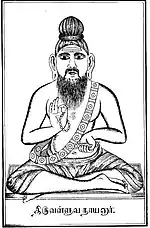
The temple was originally believed to be a village temple dedicated to Shiva during the times of Valluvar.[2] Valluvar is traditionally believed to have been born under the iluppai or butter tree within this temple complex, where he was found and taken for adoption by his foster parents.[3] Legend has it that close to the time of Valluvar's death, Elelasingan, a merchant at Mylapore and the disciple of Valluvar, expressed his desire to place Valluvar's body in a golden coffin and erect a monumental grave.[4] Refusing his request, Valluvar asked him to tie his corpse with cords and leave it among the woods outside the town in order for the wild animals to feed on it.[4] Elelasingan obliged to his mentor's wishes and, upon doing so, observed that the crows and other animals that fed on his corpse "became beautiful as gold."[4] He then built a small temple and instituted worship, where it remained for centuries.[4] The present shrine was built on the ruins of the old shrine in a grove within the existing Shiva temple complex in the early 16th century.[2][6][7] The temple is the oldest known temple ever built to Saint Valluvar.[8] The British civil servant of the Madras Presidency Francis Whyte Ellis mentions the temple in his early-19th-century stone inscription found in the Periyapalayathamman temple at Royapettah.[9] The Ekambareshwarar temple is widely considered as the birthplace of Valluvar by the public and historians,[3][6][9][10] although some additionally consider it as the place of his death and cremation.[4][6]
In his 1989 book entitled Thirumayilayin Thirukoilgal, S. Rajendran indicates that the temple was built in the early part of the 16th century.[2] The book also mentions that the temple's history is documented much earlier by Nathamuni Mudaliar in 54 Tamil verses in his work entitled Thirumayilai Thalapuranam, which chronicles the history of various Siva temples in Mylapore.[2] The revised version of the work was later published as a book by N. Singaravelan Mudaliar in 1929.[2] The Temple Directory of Madras City reports the claim that the temple was constructed by the Raja of Benares, although the dates are unknown.[6] Joanne Punzo Waghorne, professor of religion at Syracuse University, cites this claim in her work and adds that a survey from 1990 dates the temple to the 16th century.[6] She also notes that two men, one from the Naicker community and another from the Chettiar community, made some renovations in 1935 and that the remains of the ancient sacred tree was preserved and made a monument only in 1973.[6] Except for the stone idols in the temple, no traces of the original temple structure remain after the 20th-century renovation by the government.[2] The original statue of Valluvar in the shrine is said to have been taken away by the government along with several palm-leaf manuscripts that were preserved in the temple.[2] The bronze idols in the temple are believed to be made during the 19th century.[2]
The tradition of celebrating Valluvar's birthday annually on Vaikasi Anusham (a day in May) was officially accepted on 18 and 19 May 1935, when a group of Tamil scholars and researchers congregated at the Pachaiyappa's College auditorium under the leadership of Maraimalai Adigal and officially declared Valluvar year and the Valluvar Day celebrations.[11] A procession organized on the first day concluded at the Valluvar temple and a mass worship was organized at the temple on the same day.[11]
The temple
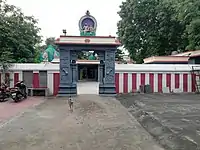
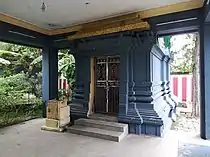
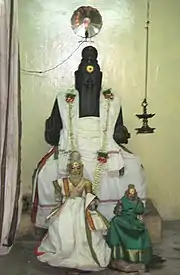
The Valluvar shrine is located within the Ekambareswarar temple complex in a narrow lane adjacent to the Valluvar statue on Royapettah High Road,[12] off Mundagakanni Amman Koil street and behind the Thanithorai market in Mylapore.[2] Situated on a 25-ground plot,[10] the temple complex has exclusive sanctums for various deities, namely, Ganesha, Subramanya, Shiva (Ekambaranathar shiva linga) and Parvathi (Kamakshi), Thiruvalluvar and his consort Vasuki,[13] the Navagrahas, and goddess Karumariamman (an incarnation of goddess Parvathi).[6][8] On a traditional clockwise circumambulatory trip around the temple corridor, the shrines of Shiva and Parvathi appear along with Ganesha and Subramanya, followed by the sanctums of Karumariamman and nagakkal (carved stone slabs depicting holy snakes) representing Nagaraja beneath a holy neem tree (Azadirachta indica) at the southwestern corner of the temple complex.[2][6] The lintel of the main shrine of Ekambaranathar bears the stucco idols of Valluvar worshiping Shiva and Parvathi. The palli arai, or the divine bedchamber, lies behind the Shiva shrine, where the processional deities are symbolically laid to rest for the day.[2]
The sanctum of Valluvar is a two-roomed shrine enclosed by an open-pillared portico known as the maha mantapam or the meditation hall.[2] The very first couplet of the Tirukkural is written at the entrance of Valluvar's sanctum. The Valluvar sanctum enshrines a large stone idol of Valluvar seated on a pedestal along with smaller bronze idols of both Valluvar and Vasuki below the pedestal. The shikhara (a large cupola over the sanctum) of the Valluvar's shrine bears stucco idols of Valluvar. The main shrine of Vasuki is found at the northwestern corner of the temple complex near the Valluvar shrine. The idol of Vasuki is patterned after the Hindu deity Kamakshi inside the sanctum.[6] The idols of all the main deities, including Ekambareshwarar, Valluvar, Vasuki, and Karumariamman face towards the east.[8] The temple shikhara (spire) above the sanctum shows scenes of Hindu life and deities, along with Valluvar reading his couplets to his wife.[6] The present sthala vriksha (sanctum tree) is located in front of the Vasuki sanctum, beside the meditation hall and the original sanctum tree. The walls of the temple are adorned with koshta images of deities such as Dakshinamurthy, Lingodbhava, Brahma, and goddess Durga. Other small sub-shrines within the temple complex include that of Hanuman, Chandikeshwara, Bhairava, and an individual shrine for Shaneeswara (planet Saturn). The processional deity of Ekambareswarar is stored in a temple vault opposite the temple's holy water well near the entrance.[2] The temple grove is located on the northern side.
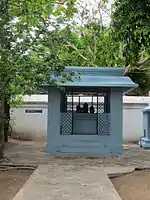
The temple's sthala vriksham (sanctum tree) is the iluppai or butter tree (Madhuca indica), grown near the original tree of the same species under which, according to tradition, Valluvar was found as a baby by his foster parents.[3][9][10] The locals believe that this is where Valluvar was born.[6] A chamber is built around the original tree.[2] A Valluvar statue in yoga position holding a palm leaf manuscript of the Tirukkural sits on the pedestal around the original tree.[6] A pedestal was built around the remains of the original tree in 1935 and is now braced up with copper sheets.[9][14] The pedestal additionally holds an idol representing the feet of Valluvar made of black granite, along with the statues of Valluvar and his parents, Sri Adhi and Sri Bhagavan, with Adhi holding the baby Valluvar in her arms.[6][9] Renovation of the temple began on 27 April 1973. Holy consecration (Kumbabishekam) of the temple took place on 23 January 2001.[14] The temple comes under the purview of the nearby Mundakakanniamman temple and is under the ambit of the Hindu religious charity department of the Government of Tamil Nadu.[14] There is also a library within the temple campus.[14] A community centre named "Valluvar–Vasuki Community Hall" has been built near the temple.[14] The temple also serves as the venue for meetings of Tamil language enthusiasts.[10] Classes on the Tirukkural are also held in the evenings for children.
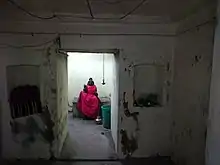
In the introduction to his 1897 book The Ethics of Kural, J. M. Nallaswamy Pillai, describes the statue at the temple thus:
Those of you, who wish to have our idea of the personal appearance of the sage, may proceed to his shrine at Mylapore, a minute's walk from the Barber's Bridge, and witness the statue of the canonized saint. The folded knot of his lock, the bushy moustache and beard sweeping over his breast, the gravity of the forehead, the broad eyes revealing his noble heart, and the grace of his majestic frame are such as remind one of Plato and Socrates. Add to these, the beads in his right and the moral code in the left hand, the saint in a sitting posture on a raised seat, seeming to impart instruction to his disciples, you will verily believe that he is a Tamil Rishi next to Agasthya. He is in fact said to be the great grandson of Agasthya. At least the genealogy framed by the pandits states so.
Rituals and festivals
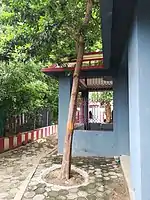
Although the official count of Nayanmars, or the canonical Saivite saints, is 63, Valluvar is often considered the 64th Nayanmar by various communities across South India as an important sign of honor,[2] and several temples have the tradition of taking the idol of Valluvar in annual procession.[16] The Valluvar temple at Mylapore, too, follows this tradition.[17] On Arubathi Moovar, the 8th day of the grand annual festival of the Kapaleeshwarar temple known as the Panguni Brahmotsavam taking place in the Tamil month of Panguni (March–April), which draws the maximum crowd during the series of events,[18] the bronze idol of Valluvar and Vasuki are also taken in procession along with the idols of the 63 Nayanmars.[17] Thus, festivals in the temple can be categorized into two, namely one for the Shiva shrine and the other for the Valluvar shrine.[2] For the Shiva shrine, the usual Shivite festivals are celebrated except the grand 10-day Brahmotsavam.[2] For the Brahmotsavam, the Valluvar–Vasuki idols are placed on a palanquin and taken in procession as part of the Kapaleeshwarar temple annual events.[17]
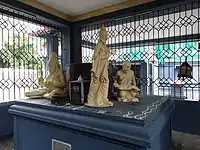
Like any other Hindu temple, the idols witness full traditional temple rituals on a daily basis. Abhishekam (bathing the idol) is performed twice a day, along with alankaram (decoration). In the morning, rice is offered as neivedhyam (offering). Draped in a white dhoti, the idol of Valluvar sports a dash of vibhuti (holy ash), kumkum (holy crimson), and sandalwood paste on the forehead.[10] The rituals are performed by the priests belonging to the Veerashaiva-Lingayat communities.[9]
Besides these daily services, special pujas are performed during the Arubathi Moovar festival (March–April), the second day of the Chitrai month (April), Thiruvalluvar day (a day notionally fixed by the Government of Tamil Nadu, falling in January), Chitra Pournami (full moon in the Tamil month of Chitrai, falling in March–April), and during the monthly Anusha star (the birth star of Valluvar).[10] Chitra Pournami is when the wedding of Valluvar and Vasuki is believed to have taken place, and hence a symbolic marriage of idols of Valluvar and Vasuki is conducted annually on this day.[2] The annual Vaikasi Anusham (Anusha star falling in the month of Vaikasi, around the month of early June) is celebrated as the birth day of the poet saint at the temple.[9][11] Maasi Utharam (Uthram star falling in the Tamil month of Maasi, in the months of February–March) is another day of significance in the temple,[9] since it is when Valluvar is believed to have attained mukthi or died.[19]
According to legend, Valluvar gave some mud to Vasuki and asked her to cook it into food in order to marry her, which she did obligingly. To commemorate this, Pongal pots are kept in front of the sanctum sanctorum and on the Chitra Pournami day (falling in April), some mud is sprinkled into these pots before boiling rice into the dish of pongal.[10]
Funds
The temple is part of temples that are under the neighbouring Sri Mundagakanniamman Temple, also at Mylapore,[10] and comes under the control of the Hindu Religious and Charity Endowment Department.[10] Being a small temple, the Valluvar temple cannot sustain itself and uses the funds from other temples.[10] The temple has no property and depends entirely on the Mundagakanni Amman Temple.[2] The temple's primary income comes from the wedding hall, a paid parking space and a few shops.[10] All the festivals are funded by devotees, and the events in the shrine are in part sponsored by the Mudaliar community, whose ancestors were Tamil scholars.[2] The ancestors of the Mudaliar community are believed to have donated the bronze idols of the shrine.[2]
Gallery
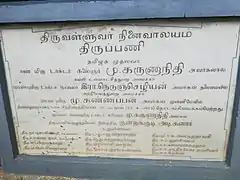 Plaque at the temple
Plaque at the temple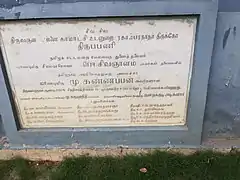 Plaque at the temple
Plaque at the temple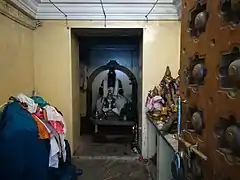 Sanctum sanctorum
Sanctum sanctorum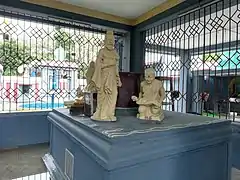 Statues at the temple
Statues at the temple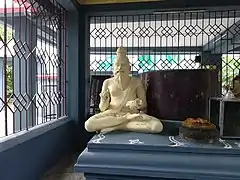 Statue of Valluvar
Statue of Valluvar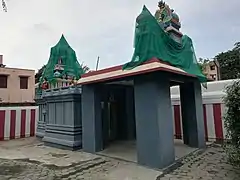 Vasuki Sanctum
Vasuki Sanctum
Citations
- Rajendran, 1989.
- Chakravarthy and Ramachandran, 2009.
- Robinson, 2001, p. 15.
- Robinson, 2001, p. 32.
- Waghorne, 2004, pp. 120–125.
- Muthiah, 2014, p. 232.
- Department of Hindu Religious and Charitable Endowments, 2014, p. 54.
- Department of Hindu Religious and Charitable Endowments, 2014, p. 55.
- Ramakrishnan, The Hindu, 15 November 2019, p. 3.
- Dinamani, 14 April 2012.
- Hindustan Times, 16 January 2020.
- Chakravarthy, 2009.
- Dinamani, 20 September 2012.
- Kannan, The New Indian Express, 11 March 2013.
- Bhatt, 2020.
- Swaminathan, The Hindu, 10 March 2014.
- Ramesh, Dinamani, 4 February 2022.
References
- Pradeep Chakravarthy, Ramesh Ramachandran (16–31 August 2009). "Thiruvalluvar's shrine". Madras Musings. 19 (9).
{{cite journal}}: CS1 maint: uses authors parameter (link) - Joanne Punzo Waghorne (2004). Diaspora of the Gods: Modern Hindu Temples in an Urban Middle-Class World. New York: Oxford University Press. ISBN 978-0-19-515663-8.
- S. Rajendran (1989). Thirumayilayin Thirukoilgal (in Tamil). Chennai.
- Ramakrishnan, Deepa H. (15 November 2019). "As a war of words rages outside, peace reigns inside this temple". The Hindu. Chennai: Kasturi & Sons. p. 3. Retrieved 5 January 2020.
- A. A. Manavalan, ed. (2009). Essays and Tributes on Tirukkural (1886–1986 AD) (1 ed.). Chennai: International Institute of Tamil Studies.
- Karthik Bhatt (16–31 March 2020). "Arupathu Moovar – 110 years ago". Madras Musings. XXIX (23).
{{cite journal}}: CS1 maint: uses authors parameter (link) - Kannan, Kaushik (11 March 2013). "Saint poet's guru pooja at Tiruchuli". The New Indian Express. Tiruchuli: Express Publications. Retrieved 3 September 2020.
- Edward Jewitt Robinson (2001). Tamil Wisdom: Traditions Concerning Hindu Sages and Selections from Their Writings. New Delhi: Asian Educational Services.
- "Thiruvalluvar Day 2020: History, significance and all you need to know about the iconic poet". Hindustan Times. HindustanTimes.com. 16 January 2020. Retrieved 21 September 2020.
- Swaminathan, Chitra (10 March 2014). "Moods of Mylapore". The Hindu. Chennai: Kasturi & Sons. Retrieved 21 November 2021.
- "பொலிவிழந்து வரும் மயிலாப்பூர் திருவள்ளுவர் கோயில்!". Dinamani (in Tamil). Chennai: The New Indian Express Group. 20 September 2012. Retrieved 2 March 2019.
- திருக்கோயில்கள் வழிகாட்டி: சென்னை மாவட்டம் (in Tamil) (1st ed.). Chennai: Government of Tamil Nadu, Department of Hindu Religious and Charitable Endowments. July 2014. pp. 54–55.
- Muthiah, S. (2014). Madras Rediscovered. Chennai: EastWest. ISBN 978-93-84030-28-5.
- "திருவள்ளுவர் திருநாளும் ஆண்டுப் பிறப்பும் [Thiruvalluvar Day and the new year]". Dinamani (in Tamil). Chennai: Dinamani. 14 April 2012. Retrieved 4 February 2022.
- Ramesh, Janani (4 February 2022). "திருவள்ளுவர் திருநாள் எந்த நாள்? [Which day is Thiruvalluvar Day?]". Dinamani (in Tamil). Chennai: Dinamani.
Further reading
- Mudaliar, Nathamuni (1929). Thirumayilai Thalapuranam. Chennai: Noble Press.
